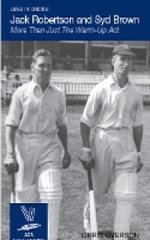Jack Robertson and Syd Brown: More Than Just The Warm-Up Act
Martin Chandler |Published: 2013
Pages: 146
Author: Overson, Chris
Publisher: ACS
Rating: 3.5 stars

I have to confess that a double biography of Jack Robertson and Syd Brown did not strike me as likely to be the brightest light in the ACS Lives in Cricket series, particularly as the name of the author, Chris Overson, is not one I am familiar with. So before I started reading I took a look at the brief profile of this new author that appears, as in all the books in the series, on the inside front cover. In it he describes himself as a batsman who had all the shots, although they usually resulted in the ball going to backward square leg. Clearly a man after my own heart, and I realised then that his book would be worth reading.
When I was a young child, poring regularly over my father’s collection of post-war Wisdens, my favourite volume was that of 1948, which chronicled the remarkable achievements of the “Middlesex twins”, Denis Compton and Bill Edrich, as they spent what must have been a gloriously sunny summer rewriting the game’s batting records. There is one page in particular that used to fascinate me, that which contains the list of Compo’s 18 centuries, listed one to a line, followed by Edrich’s 12. The symmetry of the page was maintained by virtue of the fact that it was completed by the entry for Jack Robertson, another Middlesex man, who had a dozen of his own. In any other summer his 2,760 runs at 52.07 would have dominated the season, but not in 1947.
Syd Brown was Robertson’s opening partner, and he got more than 2,000 runs in 1947 as well, but with only four tons, so he was more consistent than spectacular. Both men made their debuts in 1937, so only had a couple of summers before losing six good years to the war. They then gave loyal service to Middlesex for a number of years after the game’s resumption. Their names are rarely remembered today, although Robertson played 11 times for England. That said nine of those Tests were for sides not truly representative of the strength of English cricket, so he only played twice for a full England side, once in 1947 against South Africa, and then in 1949 he locked horns with Walter Hadlee?s New Zealanders. Brown was never selected for England.
Neither Robertson nor Brown ever courted controversy, nor did they ever make the front pages of the newspapers and, national hero Compton apart, weren’t involved with anyone who did. Indeed both seem to have been the sort of stoical, loyal and hard-working people whose life stories are never likely to fly off the shelves. While, for those reasons, I don’t suppose that Overson’s book will be a best seller it will certainly be of interest to those who like to immerse themselves in the history of the Middlesex club, and it is an interesting insight into the lives of county cricketers whose early careers were interrupted by the Second World War.
In these situations much depends upon an author’s ability to be able to breathe some life into his subjects and that is where Overson does very well. He has enjoyed the full co-operation of both men’s sons. He has also spoken to others who knew them and played with and against them. Finally, and it seems to me the importance of this can be under-stated, he has his own memories of watching Robertson bat, even if that was in the autumn of his career. He also rightly avoids too much simple regurgitation of match reports culled from elsewhere, and spends some time looking at Robertson’s overseas tours, neither of which are properly chronicled elsewhere. There are particularly good chapters dealing with the war-time experiences of Corporal Brown and Captain Robertson. There was nothing unusual about either man’s service, but it is an interesting digression from the First Class and Test cricket that is the staple content of biographies of their more illustrious contemporaries.
In conclusion I have to say that this is an excellent book, and a credit to the series which gave rise to it, and I unhesitatingly recommend it to anyone with an interest in the era. As a final word for Mr Overson, and whilst I appreciate that he is living in peaceful retirement, I am sure he must have thoroughly enjoyed the work that he put into his first contribution to the Lives in Cricket series, and he really ought to let us have an encore. It may be that he has already started a new project, but if not then I would suggest to him that Leslie Compton would be a splendid subject for his next foray into publishing.






Leave a comment